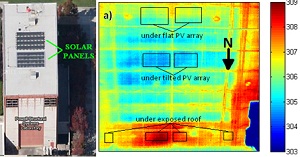Study: Unpowered, solar panels still help cool and heat buildings
 A new study by University of California (UC), San Diego found that roof-mounted photovoltaic modules can help cool a building in the day and heat it at night, adding roughly a 5 percent discount on the solar panels’ price, over the panels’ lifetime for poorly insulated buildings.
A new study by University of California (UC), San Diego found that roof-mounted photovoltaic modules can help cool a building in the day and heat it at night, adding roughly a 5 percent discount on the solar panels’ price, over the panels’ lifetime for poorly insulated buildings.
The study, led by Jan Kleissl, a professor of environmental engineering at the UC San Diego Jacobs School of Engineering, could be used to help develop modeling software to determine additional benefits of solar installations for homes and other buildings.
The study, which used thermal imaging to measure the temperature of the Powell Structural Systems Laboratory’s roof over three days in April, was funded by a NASA Graduate Student Research Program fellowship. The roof was selected since it had numerous photovoltaic panels.
The panels served as roof shades, said Anthony Dominguez, the graduate student who lead the project. In the day, the photovoltaics absorb heat that would otherwise be transferred into the building. At night, the panels release that absorbed heat, some of which is absorbed by the building.
Despite the short time over which the study was conducted, Kleissl said the data could be extrapolated to account for temperature differences and HVAC savings over a year.
“Mostly because computer models are getting better and better, a few measurements can apply to other times of the year,” he said. “So we don’t have to measure every place and every building.”
The team is looking for more funding for further study and to build software that could accurately calculate the heating and cooling impact of a solar array on a rooftop, according to Kleissl. And it would be based on existing models that studied the impacts of roofing materials on their impact on building’s interiors.
“You run these models for different conditions in California to get an estimate of savings,” he said. “I’m quite confident that these models could be applied elsewhere.”
Photovoltaic panels have a much greater impact on older, poorly insulated roofs. For instance, the lab’s roof had an R-value (insulation value) of 3. Currently in California, standards require roof insulation values of R-15, according to Kleissl.
“If you have an insulated roof, the benefits will reduce dramatically. If you took an older warehouse building, which is cooled, then you’d find better benefits,” Kleissl said. “With new roofs, you’d be hard pressed to find any difference. What we’re targeting more is the existing building market and retrofitting buildings, based on our study.”
Image courtesy of UCSD.



